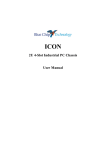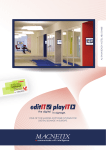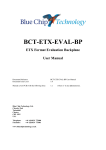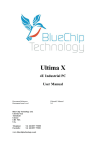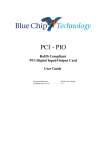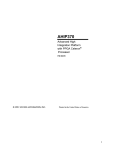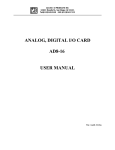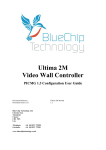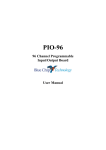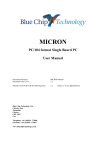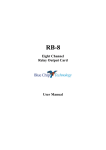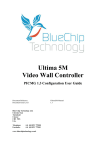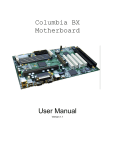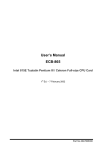Download APX-4D User Manual - Blue Chip Technology
Transcript
APX-4D Single Board PC User Manual APX-4D User Manual Document Part N° Document Reference Document Issue Level 0127-1006 APX-4D\..\127-1006.doc 1.1 Manual covers PCBs with the following Issue 1.x, A.x (x is any alpha/digit) All rights reserved. No part of this publication may be reproduced, stored in any retrieval system, or transmitted, in any form or by any means, electronic, mechanical, photocopied, recorded or otherwise, without the prior permission, in writing, from the publisher. For permission in the UK contact Blue Chip Technology. Information offered in this manual is believed to be correct at the time of printing. Blue Chip Technology accepts no responsibility for any inaccuracies. The information contained herein is subject to change without notice. There are no express or implied licences granted herein to any intellectual property rights of Blue Chip Technology Ltd. All trademarks and registered names acknowledged. Blue Chip Technology Limited, Chowley Oak, Tattenhall, Chester, Cheshire, CH3 9EX, UK Telephone: +44 (0)1829 772000 Facsimile: +44 (0)1829 772001 Website: http://www.bluechiptechnology.co.uk Amendment History Issue Level 0.1 1.0 1.1 Issue Date 11.02.98 10/07/98 15/01/01 Author PD SEJ EGW Amendment Details First draft Update corrections See ECN 98/059 Add more detail on cooling Contents INTRODUCTION................................................................................................................ 1 MANUAL OBJECTIVES ...................................................................................................... 1 LIMITATIONS OF LIABILITY ............................................................................................ 1 PRECAUTIONS .................................................................................................................... 2 Electro-Static Discharges.................................................................................................... 2 OFF-Board Battery............................................................................................................. 2 RELATED PUBLICATIONS ................................................................................................ 3 TRADEMARKS .................................................................................................................... 3 USER GUIDE....................................................................................................................... 4 OVERVIEW .......................................................................................................................... 4 Board Level Features.......................................................................................................... 5 CPU.................................................................................................................................... 5 System Memory ................................................................................................................... 5 BUS Expansion Slots........................................................................................................... 5 Electromagnetic Compatibility............................................................................................ 6 SPECIFICATION .................................................................................................................. 7 Cooling ............................................................................................................................... 7 HARDWARE DESCRIPTION............................................................................................ 8 CHIPSET............................................................................................................................... 8 M1489 CACHE MEMORY PCI CONTROLLER (CMP) ...................................................... 8 M1487 ISA BRIDGE CONTROLLER (IBC)......................................................................... 8 I/O CONTROLLER ............................................................................................................... 8 IDE Support........................................................................................................................ 8 SMC 37C665 SUPER I/O CONTROLLER............................................................................ 8 Floppy Controller ............................................................................................................... 9 Real Time Clock, CMOS RAM and Battery ......................................................................... 9 ETHERNET: REALTEK RTL8029AS .................................................................................. 9 BIOS.................................................................................................................................... 10 System Setup Utility .......................................................................................................... 10 PCI Support ...................................................................................................................... 10 ISA Plug and Play............................................................................................................. 10 Auto-Configuration Capabilities ....................................................................................... 10 Advanced Power Management .......................................................................................... 10 Sleep mode Support........................................................................................................... 11 Security features ............................................................................................................... 11 on-board connectORS ....................................................................................................... 12 Bus Connectors ................................................................................................................. 12 JUMPERS............................................................................................................................ 12 SOFTWARE DESCRIPTION ........................................................................................... 15 BIOS SETUP - PROVISIONAL .......................................................................................... 15 OVERVIEW OF THE SETUP MENU SCREENS............................................................... 15 Main Screen...................................................................................................................... 15 Overview of the Setup Keys ............................................................................................... 17 Standard Setup.................................................................................................................. 18 Advanced System Setup ..................................................................................................... 20 Quick Boot........................................................................................................................ 20 Advanced Chipset Setup .................................................................................................... 22 Power Management Setup ................................................................................................. 23 Blue Chip Technology Ltd. 01271006 Contents PCI / PnP Setup ................................................................................................................ 25 Peripheral Setup ............................................................................................................... 28 SOLID STATE DISK SUPPORT ........................................................................................ 32 ADDRESS MAPS................................................................................................................ 33 Memory Map..................................................................................................................... 33 I/O MAP ........................................................................................................................... 34 Interrupts & DMA Channels ............................................................................................. 35 CONNECTORS ................................................................................................................... 36 Ethernet UTP CONNECTOR P1 (8 way rj45 ) .................................................................. 36 Power Connector P2 (4 way 5 ¼ Disk drive connector)..................................................... 36 Auxiliary power Connector P3 (3 way molex).................................................................... 36 ECP/EPP Parallel PORT P7 (26 way header).................................................................. 37 Battery Connector P13 (4 way header).............................................................................. 40 ERROR MESSAGES........................................................................................................... 41 AMIBIOS Error Beep Codes ............................................................................................. 41 AMIBIOS Error Codes on the POST display ..................................................................... 42 AMIBIOS Error Messages................................................................................................. 44 ISA NMI Messages............................................................................................................ 46 PCI Configuration Error Messages................................................................................... 47 BOARD LAYOUT ............................................................................................................. 49 Blue Chip Technology Ltd. 01271006 Company Profile COMPANY PROFILE Blue Chip Technology is the leading specialist PC product manufacturer in UK/Europe. Blue Chip Technology provides innovation with quality design and manufacturing from a single source. Based in the North West, our purpose built complex contains one of the most advanced research and development facility, engineering workshop and production lines. Specialising in the provision of industrial computing and electronic solutions for a wide range of UK and European organisations, Blue Chip Technology has one of the UK's largest portfolios of industrial PCs, peripherals and data acquisition cards. This extensive range of products, coupled with our experience and expertise, enables Blue Chip Technology to offer an industrial processing solution for any application. The APX-4D Single Board PC is the latest addition to our portfolio, providing a cost effective product development and volume production tool for OEMs. A unique customisation and specialised system integration service is also available, delivering innovative solutions to customers problems. The company's success and reputation in this area has led to a number of large design and manufacturing projects for companies such as BNFL, Aston Martin, JaguarSport and British Gas. British Standards Institute approval (BS EN 9001) means that all of Blue Chip Technology's design and manufacturing procedures are strictly controlled, ensuring the highest levels of quality, reliability and performance. Blue Chip Technology are also committed to the single European market and continue to invest in the latest technology and skills to provide high performance computer and electronic solutions for a world-wide customer base. Blue Chip Technology Ltd. 01271006 APX-4D Manual Introduction INTRODUCTION MANUAL OBJECTIVES This manual describes in detail the Blue Chip Technology APX-4D PC104-plus Single Board Processor Card (SBPC). We have tried to include as much information as possible but we have not duplicated information that is provided in the standard IBM Technical References, unless it proved to be necessary to aid in the understanding of the APX-4D. The manual is sectioned and includes a User Guide which will help the non technical user to get the unit up and running. A Troubleshooting Guide is also included to help when things go wrong. We strongly recommend that you study this manual carefully before attempting to interface with APX-4D or change the standard configurations. Whilst all the necessary information is available in this manual we would recommend that unless you are confident, you contact your supplier for guidance. Please be aware that it is possible to create configurations within the CMOS RAM that make booting impossible. If this should happen, clear the CMOS settings, (see the description of the Jumper Settings for details). If you have any suggestions or find any errors concerning this manual and want to inform us of these, please contact our Customer Support department with the relevant details. LIMITATIONS OF LIABILITY In no event shall Blue Chip Technology be held liable for any loss, expenses or damages of any kind whatsoever, whether direct, indirect, incidental or consequential, arising from the design or use of this product or the support materials supplied with this product. If this product proves to be defective, Blue Chip Technology is only obliged to replace or refund the purchase price at Blue Chip Technology's discretion according to their Terms and Conditions of Sale. Blue Chip Technology Ltd. 01271006 Page 1 APX-4D Manual Introduction PRECAUTIONS It is imperative that precautions are taken to avoid electro-static discharges, or any maltreatment of the off-board lithium battery. ELECTRO-STATIC DISCHARGES The devices on this card can be totally destroyed by static electricity. Ensure that you take necessary static precautions, ideally wear an approved wrist strap or touch a suitable ground to discharge any static build up. This should be repeated if the handling is for any length of time. When carrying the board around, please place it into the non-conductive bag in which it came. This will prevent any static electricity build up. OFF-BOARD BATTERY This board supports an off board a Lithium battery. Great care should be taken with this type of battery. Under NO circumstances should : • the outputs be shorted • be exposed to temperatures in excess of 100°C • be burnt • be immersed in water • be unsoldered • be recharged • be disassembled If the battery is mistreated in any way there is a very real possibility of fire, explosion, and harm. Blue Chip Technology Ltd. 01271006 Page 2 APX-4D Manual Introduction RELATED PUBLICATIONS The following publications will provide useful information related to the Standard Personal Computer and can be used in conjunction with this manual. • IBM Personal Computer AT Technical Reference, 1502494, IBM, 1984. • IBM Personal System/2 and Personal Computer BIOS Interface Technical Reference, 15F0306, IBM, 1987. • The Programmers PC Sourcebook, Microsoft • The Winn L. Rosch Hardware Bible, Brady • PC104 Consortium Technical Specification TRADEMARKS IBM, PC, AT and PS/2 are trademarks of International Business Machines Corporation (IBM). AMI Hi-Flex BIOS is a trademark of American Megatrends Inc. Intel is a registered trademark of the Intel Corporation. All 80x86 and Pentium processors are registered trademarks of Intel Corporation. MSDOS and WINDOWS are registered trademarks of the Microsoft Corporation. PC/104-plus and PC/104 are registered trademarks of the PC/104 Consortium. Finali is a registered Trademark of Acer Labs Incorporated Blue Chip Technology Ltd. 01271006 Page 3 APX-4D Manual User Guide USER GUIDE OVERVIEW The Blue Chip Technology APX-4D single board PC sets new standards for integration of the latest advances in processor, memory, and I/O technologies. The APX-4D complies with the PC104+ standard form providing PCI, and ISA bus interfaces on a single card. The PC104+ is an ideal platform for the increasing requirements of today's and tomorrow's embedded applications. The design is based on the AMD Am5x86-P75 running at an internal clock rate of 133MHz providing an equivalent performance to a P75. The memory sub-system is designed to support up to 16MB of EDO DRAM (for improved performance) or standard Fast Page DRAM in standard 72-pin SODIMM sockets. The APX-4D single board PC utilises ALIs Finali PCI chipset to provide increased integration and performance over other single board PC designs. The Finali PCIset contains an integrated PCI Bus EIDE controller with a high performance IDE interface allowing up to two IDE devices (such as hard drives, CD-ROM readers, etc.). The SMC 37C665 Super I/O controller integrates the standard PC I/O functions: floppy interface, two FIFO serial ports and one EPP/ECP capable parallel port. In addition to superior hardware capabilities, a full set of software drivers and utilities are available to allow advanced operating systems such as Windows™ 95 to take full advantage of the hardware capabilities. Features such as PCI EIDE, Windows™ 95-ready Plug and Play (PnP), Advanced Power Management (APM) are available for the APX-4D. Blue Chip Technology Ltd. 01271006 Page 4 APX-4D Manual User Guide BOARD LEVEL FEATURES • AMD 5x86-P75 133MHz CPU • On-board 3.3 V CPU voltage regulator • ALI Finali PCI chipset: M1489 Cache Memory PCI Controller (CMP) M1487 ISA bridge Controller (IBC) • One SODIMM socket providing support for up to 16MByte of EDO or FPM DRAM • On board PCI NE2000 compatible Ethernet supporting 10BaseT • PC104+ (PCI) expansion bus • PC104 (ISA) expansion bus • SMC 37C665 I/O controller providing: Dual PCI IDE interface Dual floppy interface EPP/ECP bi-directional parallel interface • 2 on-board serial ports. Com 1 RS232 Com 2 RS422/485 • Real-time clock with on-board Dyna Cap (hold up for at least 72Hrs) • PS/2 mouse and keyboard support. • +5v only operation. • Optional on-board Solid State Disk 1Mbyte Flash fitted as standard 2-72Mbyte Flash expansion using Disk On Chip (DOC) CPU The APX-4D PC104+ single board PC is designed to operate with AMD Am5x86-P75 CPU running at 3.3 Volts. An on-board voltage regulator circuit provides the required voltage for the processor from the 5 volt output of a standard PC power supply. The Am5x86-P75 processor maintains full backward compatibility with the 8x86 architecture processors. It supports burst mode bus cycles, and includes an integrated unified 16KB on-chip cache which employs a write-back policy. Also integrated into the processor is an advanced numeric co-processor which significantly increases the speed of floating point operations, whilst maintaining backward compatibility with 8x87 math coprocessor and complying to ANSI/IEEE standard 754-1985. SYSTEM MEMORY The APX-4D single board PC provides a SODIMM for memory expansion. The socket support 1M x 32 (4 MB), 2M x 32 (8 MB), 4M x 32 (16 MB), 5V SODIMM modules. .. Memory timing requires 70 ns fast page devices or, for optimum performance, 60ns EDO DRAM. There are no jumper settings required for the memory size or DRAM technology this is automatically detected by the system BIOS. BUS EXPANSION SLOTS The APX 4D is designed for use in an embedded application and provides both PCI and ISA expansion via the PC/104-plus ( PCI) and standard PC/104 (ISA) connectors. There may be up to four PC/104 bus expansion cards and three PC/104-plus expansion cards. Blue Chip Technology Ltd. 01271006 Page 5 APX-4D Manual User Guide ELECTROMAGNETIC COMPATIBILITY This product meets the requirements of the European EMC Directive (89/336/EEC) and is eligible to bear the CE mark. However, because the board can be installed in a variety of computers and enclosures, certain conditions have to be applied to ensure that the compatibility is maintained. Subject to those conditions, it meets the requirements for an industrial environment (Class A product). • The board must be installed in a computer system chassis which provides screening suitable for an industrial environment. • Any recommendations made by the computer system manufacturer/supplier must be complied with regarding earthing and the installation of boards. • The board must be installed with any bulkhead plates securely screwed to the chassis of the computer to ensure good metal-to-metal (i.e. earth) contact. • Most EMC problems are caused by the external cabling to boards. It is imperative that any external cabling to the board is totally screened, and that the screen of the cable connects to the metal enclosure and hence to earth. It is recommended that round screened cables with a braided wire screen are used in preference to those with a foil screen and drain wire. Use metal connector shells which connect around the full circumference of the screen: they are far superior to those which earth the screen by a simple “pig-tail”. • The keyboard and mouse will play an important part in the compatibility of the processor card since it is a port into the board. Similarly, they will affect the compatibility of the complete system. A fully compatible keyboard and/or mouse must be used otherwise the complete system could be degraded. The keyboard/mouse themselves may radiate or behave as if keys are pressed when subject to interference. Under these circumstances it may be beneficial to add a ferrite clamp on the keyboard/mouse lead as close as possible to the connector. A suitable type is the Chomerics type H8FE-1004-AS. • Ensure that the screens of any external cables are bonded to a good RF earth at the remote end of the cable. Failure to observe these recommendations may invalidate the EMC compliance. Warning This is a Class A product. In a domestic environment this product may cause radio interference in which case the user may be required to take adequate measures. Blue Chip Technology Ltd. 01271006 Page 6 APX-4D Manual User Guide SPECIFICATION APX-4D Power Requirement Typical System Consumption +5 V ± 5% +12 V ± 5% -5 V ± 5% -12 V ± 5% 8Watts Required for processor operation. Not required for board operation The PC/104-plus and PC/104 voltage rails are linked on board. Am5x86-P75 16 MB RAM Temperature Non-Operating Operating -40°C to +80°C +0°C to +40°C (min. airflow of 15 m3/hour) +0°C to +50°C (min. airflow of 45 m3/hour) +0°C to +60°C (min. airflow of 66 m3/hour) Shock Non-Operating Half sine, 2ms, 1 m drop Vibration Non-Operating Operating 5 Hz - 500 Hz, 3.1 g RMS random 10 Hz - 500 Hz, 1.0 g RMS random EMC Emissions Immunity EN55022 (A) EN50082-2 in a Blue Chip ICON Industrial PC Chassis MTBF Estimated 40,000 Hrs Dimensions Board only 100 x 114 mm Power Consumption figures given are for a typical configuration. This information is preliminary and is provided only as a guide to calculating approximate total system power usage when additional resources are added. COOLING Efficient cooling is essential for long and reliable operation. The greater the volume of air, the greater the cooling effect and the lower the temperature rise above the ambient air temperature. However, the volume produced by any fan will vary with the pressure against which it has to work. The resistance to airflow (the back-pressure on the fan) will depend upon the enclosure, the mounting and restrictions. Therefore, when mounting and cabling the board, it is essential that the free circulation of the cooling airflow is not impeded. The calculation of airflow through an enclosure is not straightforward, and depends on many factors. The method of meeting the cooling requirements will be specific for each system. Consequently, the system builder is responsible for ensuring adequate cooling. However, interpreting airflow volumes is not intuitive. As an aid to selecting suitable cooling, the following example is offered. A 60 mm axial fan (such as a Papst type 612NGH) blowing over the board can supply up to 46 m3/hour when unrestricted. Restrictions to the airflow will reduce this volume. Blue Chip Technology Ltd. 01271006 Page 7 APX-4D Manual Hardware Description HARDWARE DESCRIPTION CHIPSET The Ali Finali PCI Chipset consists of the M1489 Cache Memory PCI controller (CMP) and the M1487 ISA Bridge Controller (IBC). M1489 CACHE MEMORY PCI CONTROLLER (CMP) The M1489 provides all control signals necessary to drive a second level cache( not implemented) and the DRAM array, including multiplexed address signals. The CMP provides access to memory and generates snoop controls to maintain cache coherency. The CMP also integrates an intelligent Host to PCI interface buffer to improve system performance. The high performance Local bus EIDE interface is also provided by the CMP. The CMP comes in a 208-pin PQFP package. M1487 ISA BRIDGE CONTROLLER (IBC) The M1487 provides the bridge between the ISA bus, PCI bus and Host Bus. It integrates the standard PC peripherals such as DMA Interrupt controllers, keyboard, RTC and Timer functions. The IBC is packaged in a 160 pin PQFP I/O CONTROLLER IDE SUPPORT The APX 4D single board PC provides two high performance PCI IDE interfaces capable of supporting PIO Mode 3 and Mode 4 devices. The system BIOS supports Logical Block Addressing (LBA) and Extended Cylinder Head Sector (ECHS) translation modes as well as ATAPI (e.g. CD-ROM) devices on both IDE interfaces. Detection of IDE device transfer rate and translation mode capability is automatically determined by the system BIOS. SMC 37C665 SUPER I/O CONTROLLER Control for the integrated serial ports, parallel port and floppy drive controller is incorporated into a single component, the SMC 37C665. This component provides: •Two powered NS16C550-compatible UARTs with send/receive 16 byte FIFO •Multi-mode bi-directional parallel port - Standard mode; IBM and Centronics compatible - Enhanced Parallel Port (EPP) with BIOS support - High Speed mode; Extended Capabilities Port (ECP) compatible •Industry standard floppy controller with 16 byte data FIFO (2.88 MB floppy support) The 37C665 is normally configured by the BIOS automatically, however configuration of these interfaces is possible via the CMOS Setup program that can be invoked during bootup. The serial ports can be enabled as COM1, COM2, or disabled. The parallel port can be Blue Chip Technology Ltd. 01271006 Page 8 APX-4D Manual Hardware Description configured as normal, extended, EPP/ECP, or disabled. The floppy interface is configurable. Header connectors allow cabling to use these interfaces. FLOPPY CONTROLLER The 37C665 is software compatible with the DP8473 and 82077 floppy disk controllers. The floppy interface can be configured for 360 KB or 1.2 MB 5¼" media or for 720 KB, 1.44 MB, or 2.88 MB 3½" media in the BIOS setup. By default, the Floppy A interface is configured for 1.44 MB and Floppy B is disabled. REAL TIME CLOCK, CMOS RAM AND BATTERY The integrated Real Time Clock (RTC) is DS1287 and MC146818 compatible and provides a time of day clock, 100-year calendar with alarm features. The RTC can be set via the BIOS SETUP program. The RTC also supports 242 bytes of battery-backed CMOS RAM in two banks which is reserved for BIOS use. The CMOS RAM can be set to specific values or cleared to the system default values using the BIOS SETUP program. Also, the CMOS RAM values can be cleared to the system defaults by using a configuration jumper on the single board PC. The appendix lists the jumper configurations. An on-board DYNACAP capacitor provides power to the RTC and CMOS memory during power down. The capacitor has an estimated hold up of 48 hours unpowered. When the APX-4D is powered up, power is drawn from the power supply. If a longer hold up period is required, the APX 4D is fitted with a standard 3.7V Lithium battery connector to allow the user to fit an external battery. ETHERNET: REALTEK RTL8029AS The APX-4D provides a highly integrated PCI 10BaseT NE2000 compatible Ethernet port. The board is fitted with an RJ45 connector for ease of interfacing. The RTL8029AS integrates the MAC, Physical chip, transceiver and SRAM buffer into a single 100pin PQFP device. The RTL8029AS supports Full duplex flow control (IEEE 802.3x). All the necessary drivers for most popular Network operating systems are supplied on a utilities disk Blue Chip Technology Ltd. 01271006 Page 9 APX-4D Manual Hardware Description BIOS The APX 4D single board PC uses an AMI system BIOS which is stored in EPROM. In addition to the System BIOS, the EPROM also contains the Setup utility, Power-On Self Tests (POST), and the PCI auto-configuration utility. This single board PC supports system BIOS shadowing, allowing the BIOS to execute from 32-bit on-board write-protected DRAM. The BIOS displays a sign-on message during POST identifying the type of BIOS and a revision code. SYSTEM SETUP UTILITY The EPROM-based Setup utility allows the configuration to be modified without removing the APX 4D from its enclosed for most basic changes. The Setup utility is accessible only during the Power-On Self Test (POST) by pressing the <DEL> key after the POST memory test has started and before boot begins. A prompt may be enabled that informs users to press the <DEL> key to access Setup. PCI SUPPORT The AMI BIOS supports Version 2.0 of the PCI BIOS specification. Support is also provided for Version 1.0 of the PCI bridge specification. PCI-to-PC Card bridging can also be supported using third party expansion cards. ISA PLUG AND PLAY The AMI BIOS incorporates ISA Plug and Play capabilities as defined by the Plug and Play Release 1.0A specification (Plug and Play BIOS Version 1.0A, ESCD Version 1.02). This allows auto-configuration of Plug and Play ISA cards, and resource management for nonPlug and Play (or legacy) ISA cards, when used in conjunction with Plug and Play aware operating systems (such as Windows™ 95). AUTO-CONFIGURATION CAPABILITIES The auto-configuration utility operates in conjunction with the system Setup utility to allow the insertion and removal of PCI and ISA Plug and Play cards to the system without user intervention (Plug & Play). When the system is turned on after adding a PCI or ISA Plug and Play card, the BIOS automatically configures interrupts, DMA channels, I/O space, and memory space. The user does not have to configure jumpers or worry about potential resource conflicts. Because PCI and ISA Plug and Play cards use the same interrupt resources as ISA cards, the user can specify the interrupts used by ISA add-in cards in the Setup utility. If using Windows™ 95, the auto-configuration utility only initialises the devices required to boot up, Windows™ 95 initialises all the other devices since it is a Plug and Play aware operating system. ADVANCED POWER MANAGEMENT The APX-4D AMI BIOS supports power management through System Management Mode (SMM) interrupts to the CPU and Advanced Power Management (APM Version 1.1). In general, power management capabilities will allow the system to be put into a power managed, Stand-by mode either by entering a user configurable hot-key sequence on the keyboard, or by the expiration of a hardware timer which detects system inactivity for a user-configurable time. When in the Stand-by mode, the APX-4D single board PC reduces power consumption by using the power saving capabilities of the Am5x86-P75 processor Blue Chip Technology Ltd. 01271006 Page 10 APX-4D Manual Hardware Description and also running down hard drives and turning off DPMS compliant monitors. Add-in cards supplied with APM-aware drivers can also be put into a power managed state for further energy savings. The ability to respond to external interrupts is fully maintained while in Stand-by mode, allowing the system to service requests (such as in-coming or network messages) while unattended, albeit slowly until the system wakes up. SLEEP MODE SUPPORT When Advanced Power Management (APM) is activated in the System BIOS and the Operating System’s APM driver is loaded, Sleep mode (Stand-By) can be entered in one of three ways. Sleep/Resume may be activated by using either a momentary-action sleep switch in the UTILS header, a keyboard hot-key sequence, or by a time-out of the system inactivity timer. Both the keyboard hot-key and the inactivity timer are programmable in the BIOS setup (timer is set to 10 minutes by default). To re-activate the system, or “Resume”, the user simply uses the keyboard or mouse, or presses the sleep switch. Note that mouse activity will only “wake up” the system if a mouse driver is loaded. While the system is in Stand-By or “Sleep” mode it is fully capable of responding to, and servicing external interrupts, even though the monitor will only turn on if a user interrupt occurs as mentioned above. SECURITY FEATURES SUPERVISOR PASSWORD If enabled, the supervisor password protects all sensitive Setup options from being changed by a user unless the password is entered (see appendix). If the password is forgotten, it may be cleared by turning off the system and clearing the CMOS RAM by removing the battery (if fitted) and allowing the CMOS capacitor to discharge. USER PASSWORD The User Password feature provides access to all setup options that do not require the supervisor password. The User Password feature also provides security during the boot process. The User Password can be enabled using the Setup utility. (At boot-up, the system will complete the operating system boot up process, but keyboard and mouse operation will be locked until the User Password is entered.) If the password is forgotten, it can be cleared by turning off the system and clearing the CMOS RAM. (As above). Blue Chip Technology Ltd. 01271006 Page 11 APX-4D Manual Hardware Description CONNECTORS A selection of connectors are incorporated on the APX-4D PC board. These provide connectivity to external peripherals (serial, parallel, keyboard, etc.), in-chassis peripherals (disk drives, etc.), and bus devices. A complete table of the available connectors and their pin-outs is given in the appendices. The PC board layout at the end of the manual shows their positions. ON-BOARD CONNECTORS There are connectors on-board for Floppy Disk Drive, IDE, LCD, Serial and parallel ports, PC/104 plus and PC/104 and utilities connector. There are also sockets for SODIMMs, Solid State Disks (Disk on Chip), Power supply and external battery. UTILITY CONNECTOR The APX-4D PC board provides a connector to support functions such as reset switch, speaker, Turbo LED, Power LED, keyboard, mouse and external SMI to invoke the power saving mode of the APX-4D. SPEAKER No on-board Piezo speaker is provided. An off-board 8ohm speaker may be connected to the header (P9 pins 1 & 2). The speaker provides error beep code information during the Power-On Self Test if the system cannot use the video interface. RESET Two pins of the utilities header P9 (pins 3 & 4) may be connected to a momentary normally open SPST switch. When the switch is closed, the system will perform a hard reset and run the POST. TURBO LED Two pins of the utilities header P9 (pins 5 & 6) may be connected to an LED to provide a light when the APX-4D is running in Turbo mode. BUS CONNECTORS The board incorporates the PC/104-plus and PC/104 bus connectors for expansion. See the appendices for the pin-out details. JUMPERS Jumpers are used on the board to select various options. Some of the jumpers are factory set to suit particular semiconductor options. These must not be disturbed, or damage to the board may ensue. Refer to the board layout drawing at the end of the manual for the positions of the various jumpers. Blue Chip Technology Ltd. 01271006 Page 12 APX-4D Manual Hardware Description Table of Jumpers JUMPER AREA OF INFLUENCE LINK ACTION J1 COM2 RS485 mode 1-2 2-3 Half Duplex Mode Full Duplex Mode J2 COM2 RS485 mode None Fitted 5V 3V3 Full Duplex Mode Half Duplex Mode 5V SODIMM 3V3 SODIMM J3 (See note) Memory operating voltage (factory fitted) Note: Currently the APX-4D will only support 5V SODIMMs. Contact BCT for further information when using 3V SODIMMs in APX-4D Blue Chip Technology Ltd. 01271006 Page 13 APX-4D Manual Software Description SOFTWARE DESCRIPTION BIOS SETUP - PROVISIONAL This section details the BIOS CMOS Setup Utility. The parameters described below are based on BIOS version 1.00; other BIOS versions may differ from the description below as new features are added. OVERVIEW OF THE SETUP MENU SCREENS The Setup program initially displays the Main menu screen. In each screen there are options for modifying the system configuration. Select a sub-menu screen by pressing the up <↑> or down <↓> arrow keys, followed by <Enter>. Within the menu use the up <↑> or down <↓> keys to select an item, then use <PgUp> or <PgDn> to modify it. For certain items, pressing <Enter> will bring up a subscreen. After you have selected an item, use the <PgUp> or <PgDn> keys to modify the setting. MAIN SCREEN Shows the following menu: Standard Setup Advanced Setup Advanced Chipset Setup Power Management Setup PCI / PnP Setup Peripheral Setup Auto Detect Hard Disk Change User Password Change Supervisor Password Auto Configuration with Optimal Settings Auto Configuration with Fail Safe Settings Save Settings and Exit Exit without Saving Their operation is shown on the following page. Blue Chip Technology Ltd. 01271006 Page 15 APX-4D Manual Software Description STANDARD SETUP For setting up and modifying basic items such as floppy disk drives, hard drives, and system time & date. ADVANCED CMOS SETUP For modifying the more advanced features of the PC (e.g. system bootup options). ADVANCED CHIPSET SETUP Modifies hardware level options. POWER MANAGEMENT SETUP For specifying the “Green PC” features such as IDE and VGA timeouts. PCI / PNP SETUP For specifying Plug and Play options (e.g. IRQ assignments). PERIPHERAL SETUP For specifying the system peripheral options such as serial and parallel port modes. AUTO DETECT HARD DISK Automatically determines the parameters of any IDE devices connected, and sets up the parameters for “USER DEFINED” drives. CHANGE USER PASSWORD Allows the password for the user level options to be set or changed. This option cannot be changed unless a supervisor password has been set. CHANGE SUPERVISOR PASSWORD Allows the password for the supervisor level options to be changed. AUTO CONFIGURATION WITH OPTIMAL SETTINGS Resets the CMOS setup options to a high performance configuration. The optimal default settings are best case values and should optimise the system performance. If CMOS RAM is corrupted, the optimal settings are loaded automatically. AUTO CONFIGURATION WITH FAIL SAFE SETTINGS Resets the CMOS setup options to a lower performance but guaranteed working configuration. The fail safe settings provide far from optimal system performance, but are the most stable settings. Use these settings as an diagnostics aid if the system is performing erratically. SAVE SETTINGS AND EXIT When selected, this allows you to save the change to CMOS and exit the Setup program. You can also press the <F10> key anywhere in the Setup program to do this. Blue Chip Technology Ltd. 01271006 Page 16 APX-4D Manual Software Description EXIT WITHOUT SAVING When selected, this allows you to exit the Setup program without saving any changes. This means that any changes made while in the Setup program will be discarded and NOT SAVED. Pressing the <Esc> key in any of the four main screens will do this. OVERVIEW OF THE SETUP KEYS SETUP KEY <F1> <Esc> <PgUp> <PgDn> <↑> <↓> <← > <→ > <F5> <F6> <F10> Blue Chip Technology Ltd. DESCRIPTION Pressing the <F1> key brings up a help screen for the currently selected item. Pressing the <Esc> key takes you back to the previous screen. Pressing it in the Main, Advanced, Security, or Exit screen allows you to Exit Discarding Changes (see later in this chapter). Pressing either key moves the selection of the current item up or down the available options. Pressing the up <↑> key changes the selection to the previous item or option. Pressing the down <↓> key changes the selection the to the next item or option. Pressing the left <← > or right <→ > keys in the Main, Advanced, Security, or Exit menu screens changes the menu screen. Pressing either key in a subscreen does nothing. Pressing the <F5> key allows you to Load Setup Defaults (see later in this chapter). Pressing the <F6> key allows you to Discard Changes (see later in this chapter). Pressing the <F10> key allows you to Exit Saving Changes (see later in this chapter). 01271006 Page 17 APX-4D Manual Software Description STANDARD SETUP This section describes the Setup options found on the standard setup screen. SYSTEM DATE When selected, this allows you to set the current date by specifying a date, month and year. SYSTEM TIME When selected, this allows you to set the current time by entering values for hours, minutes and seconds.. FLOPPY A: TYPE When selected, this allows you to cycle through the available options to specify the physical size and capacity of the diskette drive. The options are Disabled; 360 KB, 5.25inch; 1.2 MB, 5.25-inch; 720 KB, 3.5-inch; 1.44/1.25 MB, 3.5-inch; 2.88 MB, 3.5-inch. The default is 1.44 MB, 3.5-inch. FLOPPY B: TYPE When selected, this allows you to cycle through the available options to specify the physical size and capacity of the diskette drive. The options are Disabled, 360 KB, 5.25inch; 1.2 MB, 5.25-inch; 720 KB, 3.5-inch; 1.44/1.25 MB, 3.5-inch; 2.88 MB, 3.5-inch. The default is Disabled. PRIMARY IDE MASTER This reports if a primary master IDE hard disk is connected to the system and allows for the configuration of drive parameters. When selected, this allows the manual configuration of the hard drive or have the system auto configure it. The options are Auto Configured, User Definable and Disabled. There are also options for IDE CD-ROM and 46 predefined hard drive types. If you select User Definable then the Number of Cylinders, Number of Heads, and Number of Sectors can each be modified. The default for this is not installed. PRIMARY IDE SLAVE This reports if a primary slave IDE hard disk is connected to the system. It is configured exactly as described under Primary IDE Master above. The default is “Not Installed”. SECONDARY IDE MASTER This reports if a secondary master IDE hard disk is connected to the system. It is configured exactly as described under Primary IDE Master above. The default is “Not Installed”. SECONDARY IDE SLAVE This reports if a secondary slave IDE hard disk is connected to the system. It is configured exactly as described under Primary IDE Master above. The default is “Not Installed”. Blue Chip Technology Ltd. 01271006 Page 18 APX-4D Manual Software Description NUMBER OF CYLINDERS If Hard Disk Type is set to User Definable, you must type the correct number of cylinders for your hard disk. If Hard Disk Type is set to Auto Configured, this reports the number of cylinders for your hard disk and cannot be modified. NUMBER OF HEADS If Hard Disk Type is set to User Definable, you must type the correct number of heads for your hard disk. If Hard Disk Type is set to Auto Configured, this reports the number of heads for your hard disk and cannot be modified. NUMBER OF SECTORS If Hard Disk Type is set to User Definable, you must type the correct number of sectors for your hard disk. If Hard Disk Type is set to Auto Configured, this reports the number of sectors for your hard disk and cannot be modified. Blue Chip Technology Ltd. 01271006 Page 19 APX-4D Manual Software Description ADVANCED SYSTEM SETUP QUICK BOOT Set this option to “Enabled “ to instruct the BIOS to boot quickly. If set to “Enabled” the BIOS does not test memory above 1 MB and the BIOS does not wait up to 40 seconds for a READY signal from the hard drive. If the READY signal is not received immediately from the IDE drive, it is not configured (as if it was absent). The default is “Enabled”. BOOTUP SEQUENCE This option specifies the sequence of the boot drives. The options are: A:, C:, CDROM - Default C:, A:, CDROM CDROM, C:, A: BOOT UP NUM LOCK Allows you to set the start up state of “Num Lock” on your keyboard. The options are “On” and “Off”. The default is On. MOUSE SUPPORT Optimal Mouse Support disabled. (Note: the mouse option is not currently supported on the APX 4D). PRIMARY DISPLAY This option specifies the type of display monitor and adapter in the computer. The settings are Mono, CGA40, CGA80, EGA/VGA, or Absent. The Optimal and Fail-Safe default settings are EGA/VGA. PASSWORD CHECK This option enables password checking every time the computer is powered on or every time Setup is executed. If Always is chosen, a user password prompt appears every time the computer is turned on. If Setup is chosen, the password prompt appears if Setup is executed. OS/2 COMPATIBLE MODE Set this option to Yes to permit AMIBIOS to run with IBM OS/2. The settings are Enabled or Disabled. The default setting is Disabled. WAIT FOR F1 IF ERROR AMIBIOS POST error messages are followed by: Press <F1> to continue If this option is set to Disabled, AMIBIOS does not wait for you to press the <F1> key after an error message. The settings are Disabled or Enabled. The Optimal and Fail-Safe default settings are Disabled. Blue Chip Technology Ltd. 01271006 Page 20 APX-4D Manual Software Description INTERNAL CACHE This option specifies the caching algorithm used for L1 internal cache memory. The settings are : SETTING Disabled WriteBack (default) DESCRIPTION Neither L1 internal cache memory on the CPU or L2 secondary cache memory is disabled Use the write-back caching algorithm SYSTEM BIOS SHADOW CACHEABLE When this option is set to Enabled, the contents of the F0000h system memory segment can be read from or written to L1 cache memory. The contents of the F0000h memory segment are always copied from the BIOS ROM to system RAM for faster execution. The settings are Enabled or Disabled. The Optimal default setting is Enabled. The FailSafe default is Disabled. Default is Enabled. C000, 16K Shadow C400, 16K Shadow C800, 16K Shadow CC00, 16K Shadow D000, 16K Shadow D400, 16K Shadow D800, 16K Shadow DC00, 16K Shadow These options control the location of the contents of the 16KB blocks of ROM beginning at the specified memory location. If no adapter ROM is using the named ROM area, this area is made available to the local bus. The settings are : SETTING Enabled Cache Disabled DESCRIPTION The contents of C0000h - C3FFFh are written to the same address in system memory (RAM) for faster execution. The contents of the named ROM area are written to the same address in system memory (RAM) for faster execution, if an adapter ROM will be using the named ROM area. Also, the contents of the RAM area can be read from and written to cache memory. The video ROM is not copied to RAM. The contents of the video ROM cannot be read from or written to cache memory. The default setting is Cache for C000 and C400; disabled for the remainder. In the AMIBIOS for the ALI Finali chipset, the E000h page is used as ROM during POST, but shadowing is disabled and the ROM CS# signal is disabled to make the E000h page available on the local bus. Blue Chip Technology Ltd. 01271006 Page 21 APX-4D Manual Software Description ADVANCED CHIPSET SETUP AUTO CONFIG FUNCTION AT Bus Clock (options: 7.16MHz, Clk/3, Clk/4, Clk/5 or Clk/8) DRAM READ TIMING (options: slow, normal) DRAM WRITE TIMING (options: Normal, Faster or Fastest) SRAM READ TIMING (Options: 2-1-1-1, 3-1-1-1, 3-2-2-2 or 4-2-2-2) SRAM WRITE TIMING: (options: 1 WS, 0 WS) HIDDEN REFRESH (Enabled or Disabled) ISA I/O RECOVERY Blue Chip Technology Ltd. 01271006 OPTIMAL ENABLED 7.16MHz FAILSAFE DISABLED 7.16MHz Normal Normal Normal Normal 4-2-2-2 4-2-2-2 1 WS 1 WS Disabled Disabled Disabled Disabled Page 22 APX-4D Manual Software Description POWER MANAGEMENT SETUP POWER MANAGEMENT / APM Set this option to Enabled to enable the power management and APM (advanced Power Management) features. The settings are Enabled or Disabled. The default settings are Disabled. INSTANT ON SUPPORT If this option is set in Power Management / APM it allows the computer to go to full power on mode when leaving a power-conserving state. AMIBIOS uses the RTC Alarm function to wake the computer at a pre-specified time. The settings are 1 to 14 minutes, or Disabled. The default settings are Disabled. GREEN PC MONITOR POWER STATE This option specifies the power management state that the Green PC-compliant video monitor enters after the specified period of display inactivity has expired. The settings are, Disabled, Standby, or Suspend. The default settings are Disabled. VIDEO POWER DOWN MODE This option specifies the power management state that the video subsystem enters after the specified period of display inactivity has expired. The settings are Disabled, Standby or Suspend. The default settings are Disabled. HARD DISK POWER DOWN MODE This option specifies the power management state that the hard disk drive enters after the specified period of display inactivity has expired. The settings are Disabled, Standby, or Suspend. The default settings are Disabled. HARD DISK TIMEOUT (MIN) This option specifies the length of a period of hard disk inactivity. When this period expires, the hard disk drive enters the power-conserving mode specified in the Hard Disk Power Down Mode option described above. The settings are Disabled, 1 Min (minutes), and all one minute intervals up to and including 15 Min. The default settings are Disabled. STANDBY TIMEOUT This option specifies the length of the period of system inactivity when the computer is in Full-On mode before the computer is placed in Standby mode. In Standby mode, some power use is curtailed. The settings are Disabled, 1 Min, 2 Min and all one minute intervals up to and including 15 Min. The default settings are Disabled. SUSPEND TIMEOUT This option specifies the length of the period of system inactivity when the computer is already in Standby mode before the computer is placed in Suspend mode. In Suspend mode, nearly all power use is curtailed. The settings are Disabled, 1 Min, 2 Min, and all one minute intervals up to and including 15 Min. The default settings are Disabled. Blue Chip Technology Ltd. 01271006 Page 23 APX-4D Manual Software Description DISPLAY ACTIVITY This option specifies if AMIBIOS is to monitor activity on the display monitor for power conservation purposes. When this option is set to Monitor and there is no display activity for the length of time specified in the value in the Full-On to Standby Timeout (Min) option, the computer enters a power saving state. The settings are Monitor or Ignore. The default settings are Ignore. IRQ 3, 4, 5, 7, 9, 10, 11, 12, 13, 14, 15 These options enable event monitoring. When the computer is in a power saving mode, activity on the named interrupt request line is monitored by AMIBIOS. When any activity occurs, the computer enters Full On mode. Each of these options can be set to Monitor or Ignore. The provisional settings are: IRQ 3 IRQ 4 IRQ 5 IRQ 7 IRQ 9 IRQ 10 IRQ 11 IRQ 12 IRQ 13 IRQ 14 IRQ 15 Blue Chip Technology Ltd. OPTIMAL FAIL-SAFE Ignore Ignore Ignore Ignore Ignore Ignore Ignore Ignore Ignore Ignore Ignore Ignore Ignore Ignore Ignore Ignore Ignore Ignore Ignore Ignore Ignore Ignore 01271006 Page 24 APX-4D Manual Software Description PCI / PNP SETUP PLUG AND PLAY AWARE OS Set this option to Yes if the operating system installed in the computer is Plug and Playaware. AMIBIOS only detects and enables PnP ISA adapter cards that are required for system boot. The Windows 95 operating system detects and enables all other PnP-aware adapter cards. Windows 95 is PnP-aware. Set this option to No if the operating system (such as DOS, OS/2, Windows 3.x) does not use PnP. You must set this option correctly or PnP-aware adapter cards installed in your computer will not be configured properly. The settings are No or Yes. The Optimal and Fail-Safe default settings are No. PCI LATENCY TIMER (IN PCI CLOCKS) This option sets latency of all PCI devices on the PCI bus. The settings are in units equal to PCI clocks. The settings are 32, 64, 96, 128, 160, 192, 224, or 248. The Optimal and Fail-Safe default settings are 64. PCI BUS TRANSFER CONTROLS The following table lists the options for PCI Bus transfers. These should change to match the system PCI Bus requirements. PCI TRANSFER CONTROL OPTIMAL FAILSAFE CPU TO PCI WRITE BUFFER Enabled Disabled BYTE MERGE Enabled Disabled FAST BACK TO BACK Enabled Disabled PCI TO DRAM BUFFER Enabled Disabled PCI VGA PALETTE SNOOP This option must be set to Enabled if any ISA adapter card installed in the computer requires VGA palette snooping. The settings are Disabled or Enabled. The Optimal and Fail-Safe default settings are Disabled. PCI IDE BUS/MASTER Set this option to Enabled to specify that the IDE controller on the PCI local bus has bus mastering capability. The settings are Disabled or Enabled. The Optimal and Fail-Safe default settings are Disabled. OFFBOARD PCI IDE CARD This option specifies if an offboard PCI IDE controller adapter card is used in the computer. You must also specify the PCI104+ expansion slot where the offboard PCI IDE controller card is installed. If an offboard PCI IDE controller is used, the on-board IDE controller on APX-4D is automatically disabled. The settings are Disabled, Auto, Slot1, Slot2, or Slot3 Blue Chip Technology Ltd. 01271006 Page 25 APX-4D Manual Software Description If Auto is selected, AMIBIOS automatically determines the correct setting for this option. The Optimal and Fail-Safe default settings are Auto. In the AMIBIOS for the Ali Finali chipset, this option forces IRQ 14 and 15 to a PCI slot on the PCI local bus. This is necessary to support non-compliant PCI IDE adapter cards. OFFBOARD PCI IDE PRIMARY IRQ This option specifies the PCI interrupt used by the primary IDE channel on the offboard PCI IDE controller. The settings are Disabled, INTA, INTB, INTC, INTD or Hardwired. The Optimal and Fail-Safe default settings are Disabled. OFFBOARD PCI IDE SECONDARY IRQ This option specifies the PCI interrupt used by the secondary IDE channel on the offboard PCI IDE controller. The settings are Disabled, INTA, INTB, INTC, INTD or Hardwired. The Optimal and Fail-Safe default settings are Disabled. DMA CHANNELS 0, 1, 3, 5, 6, 7 These options specify the bus to which the DMA channel is allocated. These options determine if AMIBIOS should remove a DMA channel from the available pool passed to BIOS configurable devices. The available pool is determined by reading the ESCD NVRAM. If more DMA channels must be removed from the pool, the end user can use these PCI/PnP Setup options to remove the channel by assigning the option to the ISA/EISA setting. Onboard I/O is configurable by AMIBIOS. The DMA channels used by onboard I/O are configured as PCI/PnP. The provisional default settings are: Channel 0 Channel 1 Channel 3 Channel 5 Channel 6 Channel 7 OPTIMAL FAILSAFE PnP PnP PnP PnP PnP PnP PnP PnP PnP PnP PnP PnP IRQ 3, 4, 5, 7, 9, 10, 11, 14, 15 These options specify the bus that the named interrupt request lines (IRQs) are used on. These options allow you to specify IRQs for use by legacy ISA adapter cards. These options determine if AMIBIOS should remove an IRQ from the pool of available IRQs passed to BIOS configurable devices. The available IRQ pool is determined by reading the ESCD NVRAM. If more IRQs must be removed from the pool, the end user can use these PCI/PnP Setup options to remove the IRQ by assigning the option to the ISA/EISA setting. Onboard I/O is configurable by AMIBIOS. The IRQs used by onboard I/O are configured as PCI/PnP. Blue Chip Technology Ltd. 01271006 Page 26 APX-4D Manual Software Description The provisional optimal and fail-safe settings are: IRQ 3 IRQ 4 IRQ 5 IRQ 7 IRQ 9 IRQ 10 IRQ 11 IRQ 14 IRQ 15 OPTIMAL FAILSAFE PnP PnP PnP PnP PnP PnP PnP PnP PnP PnP PnP PnP PnP PnP PnP PnP PnP PnP RESERVED MEMORY SIZE This option specifies the size of the memory area reserved for legacy ISA adapter cards. The settings are Disabled, 16K, 32K, or 64K. The Optimal and Fail-Safe default settings are Disabled. RESERVED MEMORY ADDRESS This option specifies the beginning address (in hex) of the reserved memory area. The specified ROM memory area is reserved for use by legacy ISA adapter cards. The settings are C0000, C4000, C8000, CC000, D0000, D4000, D8000, DC000. The Optimal and Fail-Safe default settings are C8000. Blue Chip Technology Ltd. 01271006 Page 27 APX-4D Manual Software Description PERIPHERAL SETUP Peripheral Setup options are displayed by choosing the Peripheral Setup icon from the WINBIOS Setup main menu. All Peripheral Setup options are described in this section. ONBOARD IDE This option specifies the onboard IDE controller channels that will be used. The settings are Primary, Secondary, Both or Disabled. The Optimal and Fail-Safe default settings are Primary. ONBOARD FDC This option enables the floppy drive controller on the PC board. The settings are Auto, Enabled or Disabled. The default setting is Auto. ONBOARD SERIAL PORT1 This option enables serial port 1 on the board and specifies the based I/O port address for serial port 1. The settings are Auto, 3F8h, 3E8h, 2F8h, 2E8h, or Disabled. The default setting is Auto. ONBOARD SERIAL PORT2 This option enables serial port 2 on the board and specifies the base I/O port address for serial port 2. The settings are Auto, 3F8h, 3E8h, 2F8h, 2E8h, or Disabled. The default setting is Auto. ONBOARD PARALLEL PORT This option enables the parallel port on the board and specifies the parallel port based I/O port address. The settings are Auto, 378h, 278h, 3BCh, or Disabled. The default setting is Auto. PARALLEL PORT MODE This option specifies the parallel port mode. ECP and EPP are both bi-directional data transfer schemes that adhere to the IEEE P1284 specifications. The settings are : SETTING Normal EPP ECP Blue Chip Technology Ltd. DESCRIPTION The normal parallel port mode is used. This is the default setting. The parallel port can be used with devices that adhere to the Enhanced Parallel Port (EPP) specification. EPP uses the existing parallel port signals to provide asymmetric bi-directional data transfer driven by the host device. The parallel port can be used with devices that adhere to the Extended Capabilities Port (ECP) specification. ECP uses the DMA protocol to achieve transfer rates of approximately 2.5Mbs. ECP provides symmetric bidirectional communications. 01271006 Page 28 APX-4D Manual Software Description PARALLEL PORT IRQ Selects which IRQ is assigned to the parallel port. Available options are 5 or 7. The default is 7. PARALLEL PORT DMA This option is only available if the setting for the Parallel Port Mode option is ECP. The settings are Auto, None, DMA CH 0, DMA CH 1 or DMA CH 3. (CH = channel). The default setting is Disabled. HARDWARE IO PORT BASE ADDRESS This specifies the base address of the APX-4D configuration and control registers. The permissible options are: 100 Hex ( default) up to 700 Hex in increments of 100 Hex FLASH DISK This specifies the drive letter for the on-board flash disk to use. The options are disabled, drive A or drive B. The optimal and failsafe defaults are Disabled. See the section on Solid State Disk for more information. REMOTE DISK This specifies the serial port to be used for remote disk. The options are Disabled, COM1 or COM2. The optimal and fail safe defaults are Disabled. See the section on Serial Disk for more information. REMOTE CONSOLE This specifies the serial port to be used by the serial console. This redirects all text mode output from the APX-4D to an ANSI serial terminal. The options are Disabled, COM1 and COM2. The optimal and failsafe defaults are Disabled. See the section on Remote Console for more details. REMOTE CONTROL BAND RATE This specifies the band rate to run the remote console at. The options are 9600, 19.2K, 30.4K and 115.2K band. The optimal and failsafe defaults are 115.2K BOOT ROM Specifies the mode of operation for the ethernet boot ROM. The options are ′ Boot from local disk′ ,′ Netware RPL Server′ , ‘Windows NTAS RPL Server’, ‘Lan Server RPL Server’, ‘Lan Manager RPL Server’or ‘Other RPL Server. The optimal and failsafe defaults are ′ boot from local disk′ . SOLID STATE DISK The APX-4D SBPC supports two types of solid state disk (SSD). The first is using the 1MB of on-board FLASH disk on the APX-4D. This is programmed using the PROGFLAS utility on the disk provided and gives a 1MB read only drive which can be drive A: or drive B: The second is through the M-Systems™ Disk On Chip 2000 which can be fitted to the 32 pin DIL socket located on the top of the APX-4D. This is Blue Chip Technology Ltd. 01271006 Page 29 APX-4D Manual Software Description currently available in capacities for 2MB to 72MB and is used to emulate a hard disk drive. USING THE ON-BOARD FLASH To use the on-board FLASH as a solid state disk it first needs to be programmed with a disk image. To create this image first formate a 1.44MB floppy disk and copy the system file to it using the DOS command FORMAT A: /U /S Copy the required application files to the disk and create the AUTOEKEC.BAT and CONFIG.SYS files as required. Label the disk as ′ FLASH Image Disk′and keep in a safe place after use so that the FLASH can be reprogrammed should it become corrupt. To program the FLASH place the disk into a floppy disk drive connected to the APX-4D and issue the command PROGFLAS <drive> When <drive> specifies the drive letter of the floppy disk drive being used. REMOTE DISK Remote disk provides a way of using a floppy disk drive on a system that does not physically have a drive connected. This is achieved using a remote system (the host) and a serial cable. The cable requires no-flow control and so only TX, RX and GND need to be connected with RX being connected to TX and vice-versa. Copy the file REMSVR.SYS from the utilities disk onto the hard disk drive of the host system and add the following lines to the hosts CONFIG.SYS file DEVICE=REMSVR.SYS /n Where n specifies the COM port being used on the host. Connect the cable between the host and the APX-4D and using the setup on the APX-4D set the remote disk option to the appropriate serial port. Insert a bootable floppy disk into drive A: on the host and boot the APX-4D. As the APX-4D boots the following messages will be displayed: Initialising remote disk… If all is well ′ Remote connection OK′if remote disk fails to connect to the host ′ Error unable to correct to the host′ . If this occurs check that the drive is loaded correctly on the host and check the cable connections. While the APX-4D has booted the drive A: will be accessed via the serial link and will read the drive on the host. Remote disk data packets can be monitored on the host by running the SERVER utility on the disk supplied. SERIAL CONSOLE APX-4D provides the ability to redirect int 10h (video) text to a serial terminal or terminal emulator and to accept key strokes in return from the terminal. This uses the same 3 wire connection or remote disk (TX-RX, RX-TX, GND-GND). Blue Chip Technology Ltd. 01271006 Page 30 APX-4D Manual Software Description To enable the serial console, enter the BIOS setup and select the appropriate COM port and baud rate for the serial console and connect the cable. After the APX-4D has started to boot and displayed the sign on message for the solid state disk BIOS extension all text messages will be set to the serial terminal and not the local VGA display. Blue Chip Technology Ltd. 01271006 Page 31 APX-4D Manual Solid State Disk Support SOLID STATE DISK SUPPORT APX-4D supports the use of Solid State Disks (SSD) using either on board 1M flash device or a Disk on Chip module fitted into the 32 pin DIL socket. The on board 1Mbyte flash allows the user to copy an image of a floppy into the flash configured as a bootable write protected drive. This option provides a rugged read only drive for diskless systems. If Read and write capability is required this is acheived using the M-Systems Disk On Chip 2000 (DOC2000). This 32 pin DIL module allows Hard disk read / write emulation with disk densities ranging from 2M to 72Mbyte currently. Please contact Blue Chip Technology’s Sales for details. Blue Chip Technology Ltd. 01271006 Page 32 APX-4D User Manual Address Maps ADDRESS M APS MEMORY MAP ADDRESS RANGE (HEX) 100000 - 8000000 E0000 - FFFFF SIZE 127M 128K D8000 - DFFFF D0000 - D7FFF 32K 32K CC000 - CFFFF C8000 - CBFFF A0000 - C7FFF 16K 16K 160K 9FC00 - 9FFFF 1K 80000 - 9FBFF 00000 - 7FFFF 127K 512K Blue Chip Technology Ltd. DESCRIPTION Extended Memory AMI System BIOS (not available for UMB) Bios extensions Available HI DOS memory (opens to ISA and PCI bus) Disk on Chip Window Solid State Disk Page Video memory and BIOS ( if fitted) Extended BIOS Data (moveable by QEMM, 386MAX) Extended conventional Conventional 01271006 Page 33 APX-4D User Manual Address Maps I/O MAP The following table lists the I/O addresses used by single board PC devices. Some of these devices (e.g. graphics) may not be present in all configurations. Some devices (serial ports, parallel ports etc.) may be configured for various addresses or disabled. These I/O locations are listed in the Variable Resources column. ADDRESS (HEX) 0000 - 000F 0020 - 0021 002E - 002F 0040 - 0043 0060 0061 0064 0070, bit 7 0070, bits 6:0 0071 0080 - 008F 00A0 - 00A1 00B2 - 00B3 SIZE Bytes 16 2 2 4 1 1 1 1 bit 7 bits 1 16 2 2 00C0 - 00DE 00F0 0100 - 0107 0170 - 0177 01F0 - 01F7 0200 - 0207 0278 - 027B 02E8 - 02EF 02F8 - 02FF 0376 0377 0378 - 037F 03B0 - 03BB 03BC - 03BF 03C0 - 03DF 03E8 - 03EF 03F0 - 03F5 03F6 03F7 (Write) 03F7, bit 7 03F7, bits 6:0 03F8 - 03FF LPT + 400h 04D0 - 04D1 0CF8 - 0CFC* 0CF9 0CFC - 0CFF FFA0 - FFA7 FFA8 - FFAF FF00-FF07 31 1 8 8 8 8 4 8 8 1 1 8 4 4 16 8 6 1 1 1 bit 7 bits 8 3 2 4 1 4 8 8 8 FIXED RESOURCES VARIABLE RESOURCES DMA 1 Interrupt Controller 1 Ultra I/O configuration registers Timer 1 Keyboard Controller Data Byte NMI, speaker control Kbd Controller, CMD/STAT Byte Enable NMI RTC, Address RTC, Data DMA Page Register PIIIX - Interrupt Controller 2 APM Control / Status Interrupt Controller 2 DMA 2 Reset Numeric Error Reserved for Board Confign. Primary IDE Channel Gameport Joystick Parallel Port 2 Serial Port 4 Serial Port 2 Parallel Port 1 Video controller Parallel Port 3 Video controller Serial Port 3 Floppy Channel 1 Pri IDE Chan Cmnd Port Floppy Chan 1 Cmd Floppy Disk Chg Chan 1 Pri IDE Chan Status Port Serial Port 1 ECP regs, LPT base + 400h Edge/Level INTR Control Reg. PCI Config Address Reg. Turbo & Reset control Reg. PCI Config Data Reg 1ary Bus MasterIDE regs 2ary Bus Master IDE regs IDE Bus Master Reg. *only accessible by DWORD accesses. Blue Chip Technology Ltd. 01271006 Page 34 APX-4D User Manual Address Maps INTERRUPTS & DMA CHANNELS The following tables list the Interrupt and DMA Channel configuration options for onboard devices. The serial ports, parallel ports, and IDE controller can be configured using SETUP, or any other Plug and Play resource manager (such as the Windows™ 95 Device Manager). The Graphics interrupt is assigned by the auto-configure utility during boot up. IRQ NMI 0 1 2 3 4 5 6 7 8 9 10 11 12 13 14 15 DMA 0 1 2 3 4 5 6 7 Blue Chip Technology Ltd. RESERVED INTERRUPTS I/O Channel Check Interval Timer Keyboard buffer full Cascade interrupt from slave PIC Serial 2 (COM2) Serial 1 (COM1) Parallel 2 (LPT2) Floppy Controller Parallel (LPT1) Real time clock Cascade PS/2 Mouse (if present) Math co-processor Primary E-IDE RESERVED Floppy Cascade channel 01271006 Page 35 APX-4D User Manual Connectors CONNECTORS ETHERNET UTP CONNECTOR P1 (8 WAY RJ45 ) PIN N° 1 2 3 4 5 6 7 8 SIGNAL +VE TRANSMIT -VE TRANSMIT +VE RECEIVE NC NC -VE RECEIVE NC NC POWER CONNECTOR P2 (4 WAY 5 ¼ DISK DRIVE CONNECTOR) SIGNAL +12v Ground Ground +5V PIN N° 1 2 3 4 AUXILIARY POWER CONNECTOR P3 (3 WAY MOLEX) Pin N° 1 3 4 Signal -12 Volts DC Ground -5 Volts DC RS232 SERIAL PORT 1 P4 (10 WAY HEADER) PIN NO. 1 3 5 7 9 SIGNAL PIN NO 2 4 6 8 10 DCD RxD TxD DTR GND SIGNAL DSR RTS CTS RI Key RS485 SERIAL PORT 2 P5 (10 WAY HEADER) PIN NO. 1 3 5 7 9 Blue Chip Technology Ltd. SIGNAL Full Duplex RX +ve Full Duplex RX -ve TX +ve Full Duplex TX/RX +ve Half Duplex TX -ve Full Duplex TX/RX -ve Half Duplex 10K Pull down ( 0V) 01271006 PIN NO. 2 4 6 SIGNAL 10K pull up (+5V) NC NC 8 NC 10 NC Page 36 APX-4D User Manual Connectors PC104 + CONNECTOR (PCI BUS) P6 (120 WAY SOCKET) ROW A 1 2 3 4 5 6 7 8 9 10 11 12 13 14 15 16 17 18 19 20 21 22 23 24 25 26 27 28 29 30 SIGNAL +5V VIO (NC) AD5 C/BE0 GND AD11 AD14 3V3 (NC) ROW B 1 2 3 4 5 6 7 8 RSVD (NC) AD2 GND AD7 AD9 VIO (NC) AD13 C/BE1# ROW C 1 2 3 4 5 6 7 8 SERR# GND STOP# 3V3 (NC) FRAME# GND AD18 AD21 3V3 IDSEL0 AD24 GND AD29 +5V REQ0# GND GNT1# +5V CLK2 GND +12V -12V 9 10 11 12 13 14 15 16 17 18 19 20 21 22 23 24 25 26 27 28 29 30 GND PERR# 3V3 (NC) TRDY# GND AD16 3V3 (NC) AD20 AD23 GND C/BE3# AD26 +5V AD30 GND REQ2# VIO (NC) CLK0 +5V INTD# INTA# RSVD (NC) 9 10 11 12 13 14 15 16 17 18 19 20 21 22 23 24 25 26 27 28 29 30 SIGNAL +5V AD1 AD4 GND AD8 AD10 GND AD15 ROW D 1 2 3 4 5 6 7 8 SBO# (NC) 3V3 (NC) LOCK# GND IRDY# 3V3 (NC) AD17 GND AD22 AD21 VIO (NC) AD25 AD28 GND REQ1# +5V GNT2# GND CLK3 +5V INTB# RSVD (NC) 9 10 11 12 13 14 15 16 17 18 19 20 21 22 23 24 25 26 27 28 29 30 SIGNAL AD0 +5V AD3 AD6 GND M66NE(NC) AD12 3V3 ( NC) PAR SDONE (NC) GND DEVSEL# 3V3 (NC) C/BE2# GND AD19 3V3 (NC) AD22 AD23 GND AD27 AD31 VIO (NC) GNT0# GND CLK1 GND PCIRST# INTC# 3V3 (NC) ECP/EPP PARALLEL PORT P7 (26 WAY HEADER) PIN N° 1 3 5 7 9 11 13 15 17 19 21 23 25 Blue Chip Technology Ltd. SIGNAL -Strobe Data bit 0 Data bit 1 Data bit 2 Data bit 3 Data bit 4 Data bit 5 Data bit 6 Data bit 7 -Acknowledge Busy Paper Empty Select (Output) PIN N° 2 4 6 8 10 12 14 16 18 20 22 24 26 01271006 SIGNAL -Auto Feed XT -Error -Initialise -Select (input) Ground Ground Ground Ground Ground Ground Ground Ground Not Used Page 37 APX-4D User Manual Connectors PRIMARY E-IDE CONNECTOR P8 (40 WAY HEADER 2MM PITCH) PIN NO. 1 3 5 7 9 11 13 15 17 19 21 23 25 27 29 31 33 35 37 39 SIGNAL -Reset Data bit 7 (HD) Data bit 6 (HD) Data bit 5 (HD) Data bit 4 (HD) Data bit 3 (HD) Data bit 2 (HD) Data bit 1 (HD) Data bit 0 (HD) Ground Drive Request -IO Write (HD) -IO Read (HD) Drive Ready Drive Acknowledge IRQ14 Address 1 (HD) Address 0 (HD) -Chip Select 0 (HD) Not Used PIN NO. 2 4 6 8 10 12 14 16 18 20 22 24 26 28 30 32 34 36 38 40 SIGNAL Ground Data bit 8 (HD) Data bit 9 (HD) Data bit 10 (HD) Data bit 11 (HD) Data bit 12 (HD) Data bit 13 (HD) Data bit 14 (HD) Data bit 15 (HD) Not used Ground Ground Ground Not Used Ground HDIOCS16 Not Used Address 2 (HD) -Chip Select 1 (HD) Ground UTILITY CONNECTOR P9 (20 WAY HEADER) PIN N° 1 3 5 7 PIN N° 2 4 6 8 9 Power LED +ve 10 11 13 PS2 Mouse Data External SMI +ve 12 14 15 17 +5V (fused) External +3.6 Volt Battery Keyboard Data 16 18 19 Blue Chip Technology Ltd. SIGNAL Audio +ve Reset +ve Turbo LED +ve Turbo switch +ve 01271006 20 SIGNAL Audio -ve Reset -ve (Ground) Turbo LED -ve Turbo switch -ve (Ground) Power Led -ve ( Ground) PS2 Mouse Clock External SMI -ve (Ground) 0 Volts (Ground) 0 Volts Battery (Ground) Keyboard Clock Page 38 APX-4D User Manual Connectors FLOPPY DISK DRIVE CONNECTOR P10 (34 WAY HEADER) PIN N° 1 3 5 7 9 11 13 15 17 19 21 23 25 27 29 31 33 SIGNAL Ground Ground Ground Ground Ground Ground Ground Ground Ground Ground Ground Ground Ground Ground Ground Ground Ground PIN N° 2 4 6 8 10 12 14 16 18 20 22 24 26 28 30 32 34 SIGNAL +RPM/Low Current Not used Not used -Index -Motor 0 -Drive select 1 -Drive select 0 -Motor 1 +Direction -Step -Write Data -Write Gate -Track 0 -Write Protect -Read Data +Head Select +Disk Change PC104 PC/XT CONNECTOR (ISA BUS) P11 (64 WAY SOCKET) SIDE A 1 2 3 4 5 6 7 8 9 10 11 12 13 14 15 16 17 18 19 20 21 22 23 24 25 26 27 28 29 30 31 32 Blue Chip Technology Ltd. SIGNAL -IOCHCK SD7 SD6 SD5 SD4 SD3 SD2 SD1 SD0 IOCHRDY AEN SA19 SA18 SA17 SA16 SA15 SA14 SA13 SA12 SA11 SA10 SA9 SA8 SA7 SA6 SA5 SA4 SA3 SA2 SA1 SA0 Ground SIDE B 1 2 3 4 5 6 7 8 9 10 11 12 13 14 15 16 17 18 19 20 21 22 23 24 25 26 27 28 29 30 31 32 01271006 SIGNAL Ground Resetdrv +5 Volts IRQ9 -5 Volts DREQ2 -12 Volts -0WS +12 Volts Ground -SMEMW -SMEMR -IOW -IOR -DACK3 DREQ3 -DACK1 DREQ1 -REF CLK IRQ7 IRQ6 IRQ5 IRQ4 IRQ3 -DACK2 T/C BALE +5 Volts OSC Ground Ground Page 39 APX-4D User Manual Connectors PC104 PC/AT CONNECTOR P12 (40 WAY SOCKET) SIDE C 1 2 3 4 5 6 7 8 9 10 11 12 13 14 15 16 17 18 19 20 SIGNAL Ground -SBHE LA23 LA22 LA21 LA20 LA19 LA18 LA17 -MEMR -MEMW SD8 SD9 SD10 SD11 SD12 SD13 SD14 SD15 No Connection SIDE D 1 2 3 4 5 6 7 8 9 10 11 12 13 14 15 16 17 18 19 20 SIGNAL Ground -MEMCS16 -IOCS16 IRQ10 IRQ11 IRQ12 IRQ15 IRQ14 -DACK0 DREQ0 -DACK5 DREQ5 -DACK6 DREQ6 -DACK7 DREQ7 +5 Volts -Master Ground Ground BATTERY CONNECTOR P13 (4 WAY HEADER) Pin N° 1 2 3 4 Blue Chip Technology Ltd. Signal +3.7 Volts DC Not used (key) Ground Ground 01271006 Page 40 APX-4D User Manual Error Messages ERROR MESSAGES AMIBIOS ERROR BEEP CODES The BIOS performs a Power On Self Test (POST) after a reset or reboot. If errors occur during the POST, the microprocessor indicates the status of the test by writing codes to the I/O port at address 80 Hex. If the BIOS cannot find and configure the display controller then the errors are communicated through a series of audible beeps (by the speaker drive circuit). Fatal errors, which prevent the system from continuing the boot process, will produce beep codes. Other errors are displayed textually. For these see AMIBIOS Error Messages, in the following subsection. BEEPS 1long, 3 short 1 ERROR MESSAGE Video failure DESCRIPTION A connection to a monitor was not detected. Refresh Failure 2 3 Parity Error Base 64 KB Memory Failure Timer Not Operational Processor Error 8042 - Gate A20 Failure Processor Exception Interrupt Error Display Memory Read/Write Error ROM Checksum Error CMOS Shutdown Register Rd/Wrt Error Cache Error / External Cache Bad The memory refresh circuitry on the single board PC is faulty. Parity is not supported on this product, will not occur. Memory failure in the first 64 KB. 4 5 6 7 8 9 10 11 Blue Chip Technology Ltd. Memory failure in the first 64 KB of memory, or Timer 1 on the single board PC is not functioning. The CPU on the single board PC generated an error. The keyboard controller (8042) may be bad. The BIOS cannot switch to protected mode. The CPU generated an exception interrupt. System video adapter is either missing or its memory is faulty. This is not a fatal error. ROM checksum value does not match the value encoded in BIOS. The shutdown register for CMOS RAM failed. The external cache is faulty. 01271006 Page 41 APX-4D User Manual Error Messages AMIBIOS ERROR CODES ON THE POST DISPLAY As the BIOS performs the POST after a reset or reboot, the microprocessor indicates the status of the test by writing codes to the I/O port at address 80 Hex. The following codes indicate the progress of the microprocessor during the power on test. UNCOMPRESSED INIT CODE CHECKPOINTS CODE (HEX) D0 D1 D3 D4 D5 D6 D7 DESCRIPTION NMI is Disabled. CPU ID saved. Init code Checksum verification starting. To do DMA init, Keyboard controller BAT test, start memory refresh and going to 4GB flat mode. To start Memory sizing. To come back to real mode. Execute OEM patch. Set stack. E000 ROM enabled. Init code is copied to segment 0 and control to be transfered to segment 0. Control is in segment 0. To check <CTRL><HOME> key and verify main BIOS checksum. If either <CTRL><HOME> is pressed or main BIOS checksum is bad, go to check point E0 else goto check point D7. Main BIOS runtime code is to be decompressed and control to be passed to main BIOS in shadow RAM. BOOT BLOCK RECOVERY CODE CHECKPOINTS CODE (HEX) E0 E1 E2 E6 ED EE EF F0 F1 F2 F3 F4 F5 FB FC FD FF DESCRIPTION On-Board Floppy Controller (if any) is initialised. To start base 512K memory test. To initialise interrupt vector table. To initialise DMA and interrupt controllers. To enable floppy and timer IRQ, enable internal cache. Initialize floppy drive. Start looking for a diskette in drive A: and read 1st sector of the diskette. Floppy read error. Start searching ‘AMIBOOT.ROM’file in root directory. ‘AMIBOOT.ROM’file not present in root directory. Start reading FAT table and analyze FAT to find the clusters occupied by ‘AMIBOOT.ROM’file.. Start reading ‘AMIBOOT.ROM’file cluster by cluster. ‘AMIBOOT.ROM’file not of proper size. Disable internal cache. Detect Flash type present. Erase Flash. Program Flash. Flash program successful. BIOS is going to restart. These Checkpoints are only utilised when the APX-4D is fitted with a Flash BIOS Blue Chip Technology Ltd. 01271006 Page 42 APX-4D User Manual Error Messages RUNTIME CODE IS UNCOMPRESSED IN F000 SHADOW RAM CODE (HEX) 03 05 06 07 08 0B 0C 0E 0F 10 11 12 13 14 19 1A 23 24 25 27 28 2A 2B 2C 2D 2E 2F 30 31 32 34 37 38 39 3A 40 42 43 44 45 46 47 48 49 4B 4C 4D 4E 4F 50 51 52 53 54 57 58 59 60 DESCRIPTION NMI is Disabled. To check soft reset/power-on. BIOS stack set. Going to disable Cache if any. POST code to be uncompressed. CPU init and CPU data area init to be done. CMOS checksum calculation to be done next. Any initialisation before keyboard BAT to be done next. KB controller I/B free. To issue the BAT command to keyboard controller. Any initialisation after KB controller BAT to be done next. Keyboard command byte to be written. Going to issue Pin-23,24 blocking/unblocking command. Going to check pressing of <INS> , <END> key during power-on. To init CMOS if “Init CMOS in every boot”is set or <END> key is pressed. Going to disable DMA and Interrupt controllers. Video display is disabled and port-B is initialised. Chipset init about to begin. 8254 timer test about to start. About to start memory refresh test. Memory Refresh line is toggling. Going to check 15us ON/OFF time. To read 8042 input port and disable Megakey GreenPC feature. Make BIOS code segment writeable. To do any setup before Int vector init. Interrupt vector initialisation about to begin. To clear password if necessary. Any initialisation before setting video mode to be done. Going for monochrome mode and colour mode setting. Different BUSes init (system, static, output devices) to start if present. To give control for any setup required before optional video ROM check. To look for optional video ROM and give control. To give control to do any processing after video ROM returns control. If EGA/VGA not found then do display memory R/W test. EGA/VGA not found. Display memory R/W test about to begin. Display memory R/W test passed. About to look for the retrace checking. Display memory R/W test or retrace checking failed. To do alternate Display memory R/W test. Alternate Display memory R/W test passed. To look for the alternate display retrace checking. Video display checking over. Display mode to be set next. Display mode set. Going to display the power on message. Different BUSes init (input, IPL, general devices) to start if present. Display different BUSes initialisation error messages. New cursor position read and saved. To display the Hit <DEL> message. To prepare the descriptor tables. To enter in virtual mode for memory test. To enable interrupts for diagnostics mode. To Initialize data to check memory wrap around at 0:0. Data initialised. Going to check for memory wrap around at 0:0 and finding the total system memory size. Memory wrap around test done. Memory size calculation over. About to go for writing patterns to test memory. Pattern to be tested written in extended memory. Going to write patterns in base 640k memory. Patterns written in base memory. Going to find out amount of memory below 1M memory. Amount of memory below 1M found and verified. Going to find out amount of memory above 1M memory. Amount of memory above 1M found and verified. Check for soft reset and going to clear memory below 1M for soft reset. (If power on, go to check point# 4Eh). Memory below 1M cleared. (SOFT RESET) Going to clear memory above 1M. Memory above 1M cleared. (SOFT RESET) Going to save the memory size. (Goto check point# 52h). Memory test started. (NOT SOFT RESET) About to display the first 64k memory size. Memory size display started. This will be updated during memory test. Going for sequential and random memory test. Memory testing/initialisation below 1M complete. Going to adjust displayed memory size for relocation/ shadow. Memory size display adjusted due to relocation/ shadow. Memory test above 1M to follow. Memory testing/initialisation above 1M complete. Going to save memory size information. Memory size information is saved. CPU registers are saved. Going to enter in real mode. Shutdown successful, CPU in real mode. Going to disable gate A20 line and disable parity/NMI. A20 address line, parity/NMI disable successful. Going to adjust memory size depending on relocation/shadow. Memory size adjusted for relocation/shadow. Going to clear Hit <DEL> message. Hit <DEL> message cleared. <WAIT...> message displayed. About to start DMA and interrupt controller test. DMA page register test passed. To do DMA#1 base register test. Blue Chip Technology Ltd. 01271006 Page 43 APX-4D User Manual 62 65 66 7F 80 81 82 83 84 85 86 87 88 89 8B 8C 8D 8F 91 95 96 97 98 99 9A 9B 9C 9D 9E A2 A3 A4 A5 A7 A8 A9 AA AB B0 B1 00 Error Messages DMA#1 base register test passed. To do DMA#2 base register test. DMA#2 base register test passed. To program DMA unit 1 and 2. DMA unit 1 and 2 programming over. To Initialize 8259 interrupt controller. Extended NMI sources enabling is in progress. Keyboard test started. clearing output buffer, checking for stuck key, to issue keyboard reset command. Kb reset error/stuck key found. To issue kb controller test command. Keyboard controller interface test over. To write command byte and init circular buffer. Command byte written, Global data init done. To check for lock-key. Lock-key checking over. To check for memory size mismatch with CMOS. Memory size check done. To display soft error and check for password or bypass setup. Password checked. About to do programming before setup. Programming before setup complete. To uncompress SETUP code and execute CMOS setup. Returned from CMOS setup program and screen is cleared. About to do programming after setup. Programming after setup complete. Going to display power on screen message. First screen message displayed. <WAIT...> message displayed. PS/2 Mouse check and extended BIOS data area allocation to be done. Setup options programming after CMOS setup about to start. Going for hard disk controller reset. Hard disk controller reset done. Floppy setup to be done next. Floppy setup complete. Hard disk setup to be done next. Init of different BUSes optional ROMs from C800 to start. Going to do any init before C800 optional ROM control. Any init before C800 optional ROM control is over. Optional ROM check and control will be done next. Optional ROM control is done. About to give control to do any required processing after optional ROM returns control and enable external cache. Any initialisation required after optional ROM test over. Going to setup timer data area and printer base address. Return after setting timer and printer base address. Going to set the RS-232 base address. Returned after RS-232 base address. Going to do any initialisation before Coprocessor test Required initialisation before Coprocessor is over. Going to Initialize the Coprocessor next. Coprocessor initialised. Going to do any initialisation after Coprocessor test. Initialisation after Coprocessor test is complete. Going to check extd keyboard, keyboard ID and numlock. Keyboard ID command to be Going to display any soft errors. Soft error display complete. Going to set keyboard typematic rate. Keyboard typematic rate set. To program memory wait states. Going to enable parity/NMI. NMI and parity enabled. Going to do any initialisation required before giving control to optional ROM at E000. Initialisation before E000 ROM control over. E000 ROM to get control next. Returned from E000 ROM control. Going to do any initialisation required after E000 optional ROM control. Initialisation after E000 optional ROM control is over. Going to display the system configuration. To uncompress DMI data and execute DMI POST init. System configuration is displayed. Going to copy any code to specific area. Copying of code to specific area done. Going to give control to INT-19 boot loader. AMIBIOS ERROR MESSAGES Textual error messages are displayed in the following format: ERROR Message Line 1 ERROR Message Line 2 For most displayed error messages, there is only one message. If a second message appears, it is "RUN SETUP". If this message occurs, press <F1> to run Setup Utility. The table of messages is shown on the next page. Blue Chip Technology Ltd. 01271006 Page 44 APX-4D User Manual ERROR MESSAGE 8042 Gate - A20 Error Address Line Short! Cache Memory Bad, Do Not Enable Cache! CH-2 Timer Error CMOS Battery State Low CMOS Checksum Failure CMOS System Options Not Set CMOS Display Type Mismatch CMOS Memory Size Mismatch CMOS Time and Date Not Set Diskette Boot Failure Display Switch Not Proper DMA Error DMA #1 Error DMA #2 Error FDD Controller Failure HDD Controller Failure INTR #1 Error INTR #2 Error Invalid Boot Diskette Keyboard Is Locked...Unlock It Keyboard Error KB/Interface Error Off Board Parity Error On Board Parity Error Parity Error ???? Blue Chip Technology Ltd. Error Messages EXPLANATION Gate A20 on the keyboard controller (8042) is not working. Replace the 8042. Error in the address decoding circuitry on the single board PC. Cache memory is defective. Replace it. Most AT systems include two timers. There is an error in timer 2. CMOS RAM is powered by a battery. The battery power is low. Replace the battery. After CMOS RAM values are saved, a checksum value is generated for error checking. The previous value is different from the current value. Run AMIBIOS Setup. The values stored in CMOS RAM are either corrupt or non-existent. Run Setup. The video type in CMOS RAM does not match the type detected by the BIOS. Run AMIBIOS Setup. The amount of memory on the single board PC is different than the amount in CMOS RAM. Run AMIBIOS Setup. Run Standard CMOS Setup to set the date and time in CMOS RAM. The boot disk in floppy drive A: is corrupt. It cannot be used to boot the system. Use another boot disk and follow the screen instructions. The display jumper is not implemented on this product, this error will not occur. Error in the DMA controller. Error in the first DMA channel. Error in the second DMA channel. The BIOS cannot communicate with the floppy disk drive controller. Check all appropriate connections after the system is powered down. The BIOS cannot communicate with the hard disk drive controller. Check all appropriate connections after the system is powered down. Interrupt channel 1 failed POST. Interrupt channel 2 failed POST. The BIOS can read the disk in floppy drive A:, but cannot boot the system. Use another boot disk. The keyboard lock on the system is engaged. The system must be unlocked to continue. There is a timing problem with the keyboard. Set the Keyboard option in Standard CMOS Setup to Not Installed to skip the keyboard POST routines. There is an error in the keyboard connector. Parity error in memory installed in an expansion slot. The format is: OFF BOARD PARITY ERROR ADDR (HEX) = (XXXX) Where “XXXX”is the hex address where the error occurred. Parity is not supported on this product, this error will not occur. Parity error in system memory at an unknown address. 01271006 Page 45 APX-4D User Manual Error Messages ISA NMI MESSAGES ISA NMI MESSAGE Memory Parity Error at XXXXX I/O Card Parity Error at XXXXX DMA Bus Time-out Blue Chip Technology Ltd. EXPLANATION Memory failed. If the memory location can be determined, it is displayed as XXXXX. If not, the message is Memory Parity Error ????. An expansion card failed. If the address can be determined, it is displayed as XXXXX. If not, the message is I/O Card Parity Error ????. A device has driven the bus signal for more than 7.8 microseconds. 01271006 Page 46 APX-4D User Manual Error Messages PCI CONFIGURATION ERROR MESSAGES The following PCI messages are displayed as a group with bus, device and function information. <'NVRAM Checksum Error, NVRAM Cleared'>, \ ; String <'System Board Device Resource Conflict'>, \ ; String <'Primary Output Device Not Found'>, \ ; String <'Primary Input Device Not Found'>, \ ; String <'Primary Boot Device Not Found'>, \ ; String <'NVRAM Cleared By Jumper'>, \ ; String <'NVRAM Data Invalid, NVRAM Cleared'>, \ ; String <'Static Device Resource Conflict'>, \ ; String The following messages chain together to give a message such as: "PCI I/O Port Conflict: Bus: 00, Device 0D, Function: 01". If and when more than 15 PCI conflict errors are detected, the log full message is displayed. <'PCI I/O Port Conflict:'>, \ ; String <'PCI Memory Conflict: '>, \ ; String <'PCI IRQ Conflict: '>, \ ; String <' Bus '>, \ ; String <', Device '>, \ ; String <', Function '>, \ ; String <'PCI Error Log is Full.'>, \ ; String <'Floppy Disk Controller Resource Conflict '>, \ ; Text <'Primary IDE Controller Resource Conflict '>, \ ; Text <'Secondary IDE Controller Resource Conflict '>, \ ; Text <'Parallel Port Resource Conflict '>, \ ; Text <'Serial Port 1 Resource Conflict '>, \ ; Text <'Serial Port 2 Resource Conflict '>, \ ; Text Blue Chip Technology Ltd. 01271006 Page 47 APX-4D User Manual Board Layout BOARD LAYOUT Blue Chip Technology Ltd. 01271006 Page 49























































